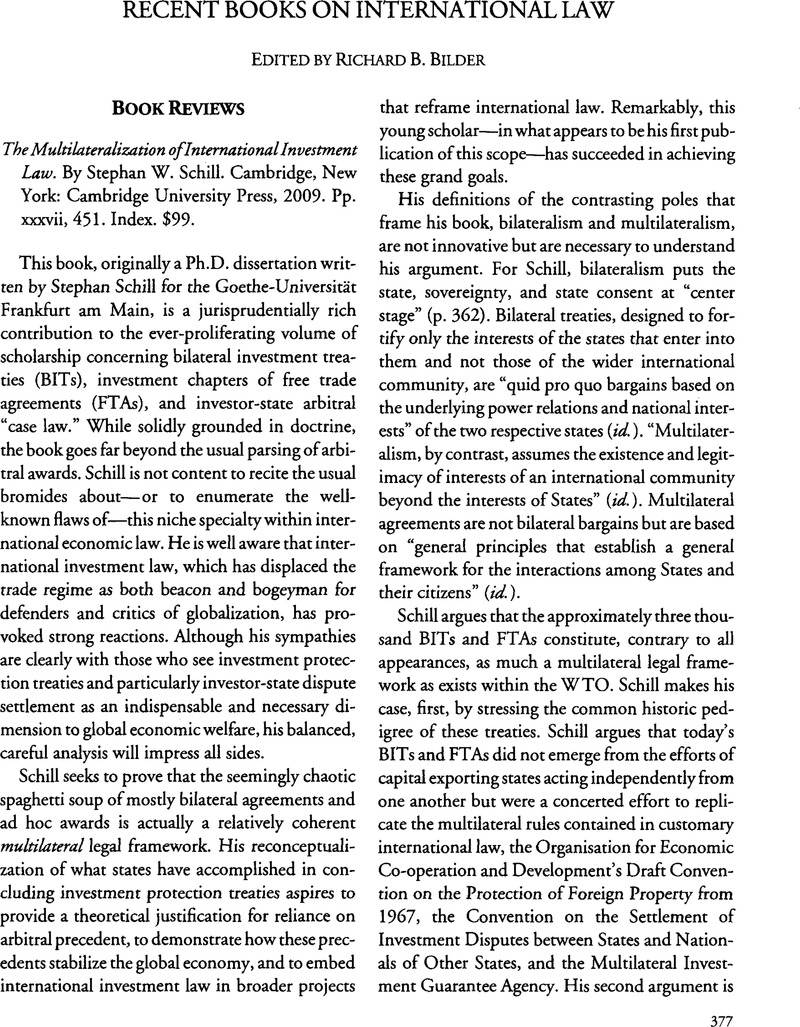No CrossRef data available.
Published online by Cambridge University Press: 27 February 2017

1 In later work Schill has pursued precisely this goal. See International Investment Law and Comparative Public Law (Stephan W., Schill ed., 2010).Google Scholar
2 See Benedict, Kingsbury & Stephan, Schill, Investor-State Arbitration as Governance: Fair and Equitable Treatment, Proportionality and the Emerging Global Administrative Law, in El Nuevo Derecho Administrativo Global En América Latina: Desafíos Para Las Inversiones Extranjeras, La Regulación Nacional Y El Financiamiento Para El Desarrollo 221 (2009).Google Scholar
3 See, e.g., Deborah Z., Cass, The Constitutionalization of The World Trade Organization: Legitimacy, Democracy and Community in The International Trading System (2005)Google Scholar
4 David, Schneiderman, Constitutionalizing Economic Globalization: Investment Rules and Democracy’s Promise (2008).Google Scholar
5 See, e.g., Dennis, Patterson & Ari, Afilalo, The New Global Trading Order: The Evolving State and The Future of Trade (2008).Google Scholar
6 See Gus Van, Harten, Investment Treaty Arbitration and Public Law (2007) (reviewed by José E., Alvarez at 102 AJIL 909 (2008)).Google Scholar
7 See also Gus Van, Harten, Five Justifications for Investment Treaties: A Critical Discussion, 2 Trade, L. & Dev. 19 (2010)Google Scholar ; Stephan W., Schill, The Multilaterialization of International Investment Law: Emergence of a Multilateral System of Investment Protection on Bilateral Grounds, 2 Trade, L. & Dev. 59 (2010).Google Scholar
8 See also Osgoode, Hall, Public Statement on the International Investment Regime (Aug. 31, 2010), at http://www.osgoode.yorku.ca/public_statement/documents/Public%20Statement.pdf (statement signed by thirty seven academics and led by Gus Van Harten).Google Scholar
9 See, e.g., Restatement (Third) of Foreign Relations law of The United States § 102 cmt. i (1986) (“A wide network of similar bilateral arrangements on a subject may constitute practice and also result in customary law.”).
10 See , e.g., B. S. Chimni, International Institutions Today: An Imperial Global State in the Making, 15 eur. J. Int‘l L. 1 (2004); José e. Alvarez, Hegemonic International Law Revisited, 97 AJIL 873 (2003)
11 See, e.g., Susan, Marks, Big Brother is Bleeping Us—With the Message that Ideology Doesn’t Matter, 12 Eur. J. Int’l L. 109 (2001).Google Scholar
12 See also José E., Alvarez, Contemporary Foreign Investment Law: An “Empire of Law” or the “Law of Empire”?, 60 Ala. L. Rev. 943 (2009) (Meador Lecture).Google Scholar
13 See Daniel, Kalderimis, IMF Conditionality as Investment Regulation: A Theoretical Analysis, 13 Soc. & Leg. Stud. 104 (2004).Google Scholar
14 See, e.g., Unctad World Investment Report 2010: Investing in a Low-carbon Economy, 83–88, available at http://www.unctad.org/Templates/WebFlyer.asp?intItemID=5539&lang=1 (surveying these developments); José E. Alvarez, The Return of the State, 20 Minn. J. Int’l L. (forthcoming 2011).
15 See, e.g., José E., Alvarez, The Evolving BIT, in Investment Treaty Arbitration and International Law 1 (Ian A., Laird & Todd, Weiler eds., 2010)Google Scholar ; see also Stephen W., Schwebel, The United States 2004 Model Bilateral Investment Treaty: An Exercise in the Regressive Development of International Law, 3:2 Transnat’l Disp. Mgmt., Apr. 2006.Google Scholar
16 See, e.g., Alvarez, supra note 15, at 12–13.
17 See, e.g., Kenneth J., Vandevelde, A Comparison of the 2004and1994 U.S. Model BITs, Y.B. Int’l Inv. L. & Pol’y 2008-2009,Google Scholar at 283, 301 (Karl P. Sauvant ed., 2009) (indicating that since the adoption of the U.S. Model BIT of 2004, the United States has reserved the right to adopt or maintain any measure that accords differential treatment to countries under prior BITs and FTAs, thereby permitting the United States “to provide a lesser level of protection in any agreement in which the reservation appears than under prior agreements, notwithstanding the MFN provision”).
18 See, e.g., Joseph E., Stiglitz, Globalization and its Discontents (2002) (criticizing the promulgation of the “Washington Consensus”)Google Scholar ; Dani, Rodrik, Growth Strategies, in Handbook of Economic Growth 967 (Philippe, Aghion & Steven N., Durlauf eds., 2005)Google Scholar (arguing that pursuit of the Washington Consensus model has not produced economic development as anticipated), available at http://econ2.econ.iastate.edu/classes/econ502/tesfatsion/Growth Strategies.DRodrik.GrowthHB2005.pdf.
19 See also Schill, supra note 7, at 75.
20 See Anne Van, Aaken and Jürgen, Kurtz, Emergency Measures and International Investment Law: How Far Can States Go?, Y.B. Int’l Inv. L. & Pol’y 2009–2010, at 505 (Karl P., Sauvant ed., 2010).Google Scholar
21 See, e.g., Kenneth J., Vandevelde, Investment Liberalization and Economic Development: The Role of Bilateral Investment Treaties, 36 Colum. J. Transnat’l L. 501 (1998).Google Scholar
22 See Alvarez, supra note 14 (manuscript at 18–25) (describing how the annulment rulings in CMS v. Argentina, Sempra v. Argentina, and Enron v. Argentina serve to empower the state).